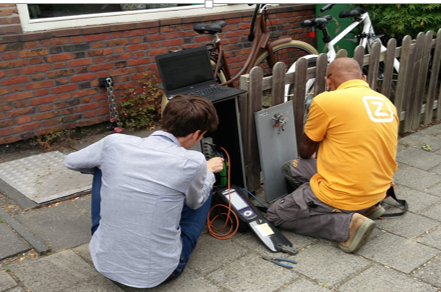VodafoneZiggo has partnered with Xomnia to automate the process of identifying the root causes of noise in the cable network. With the aid of our Machine Learning Engineers Chiel Peters and Marius Helf, the telecommunication provider developed a dashboard that employs anomaly detection to find out which households have a bad connection, and then try to logically derive the root of the problem.
The solution, which has been in production since late 2018, consists of a time series model algorithm and a dashboard for the network engineers. It helps the telecommunications provider to proactively and accurately spot failures in the network, and overcome hurdles traditionally caused by complex interactions and dependencies (both hardware and software) in the environment in which the network operates.
Challenge
Vodafoneziggo delivers connectivity via cables under the ground, which branch off to small boxes that cater to individual houses. Sometimes, disruptions in the physical environment around the cables might displace the cables, resulting in a slow or unreliable internet network.
Vodafoneziggo faced two challenges when trying to resolve this issue. Firstly, detecting such noise was time consuming and happened mainly reactively based on customer feedback.
Secondly, its technicians faced issues in detecting the root cause of such problems, as they could be due to a loose or corroded cable or a broken component. It is hard for a technician to locate the true root cause of the noise because the network is interconnected, making an issue in one place in the network resonate in many other places. Moreover, a technician might not find the instability issue in the network because it might be resolved at the time that he/she arrives, only to potentially reappear later.
Achieve your organization's full potential Xomnia with the leading AI consultancy in the Netherlands
Solution
All equipment sends high level signal diagnostic information back to Vodafoneziggo to be analyzed. Using this information, the telecommunications provider wanted to find a way to help the technicians in monitoring the network and proactively finding the root cause of connection problems.
Xomnia worked with VodafoneZiggo to develop a time series algorithm that picks up deviations in the network. The application consists of two core elements, an algorithm and a dashboard:
- The algorithm is a time series model with custom time dependent features modeled after domain knowledge from the network engineers. It was written in Python with Apache Spark and can process millions of signals on network performance in a matter of minutes. It runs within VodafoneZiggo’s virtual private network.
- The dashboard was written in Python using the Flask framework alongside HTML and Javascript for front-end development. Network engineers can view the dashboard live in the field and proactively monitor the physical network.
Any anomalies in the signal qualities of customers are detected and aggregated back to the responsible component(s). This information is then fed back on an hourly basis to the network engineers, who can go directly to the faulty component without tedious manual analysis. The second step is locating the origin of the problem. The dashboard would aggregate information about where a bad connection exists, to estimate where it started and where it originated.

Don't miss Xomnia's latest business cases and blogs. Subscribe to our newsletter.
Impact
Automated deviation detection generated benefits for all stakeholders, improving operational processes, service level repairs, and the customer experience with fewer disruptions. Future use cases anticipate predicting failures so far in advance that can be solved before impacting customers.
Using the dashboard, network engineers can see every morning the noise’s root causes, and proactively send technicians to fix them, instead of waiting for it to get worse and a customer to raise a complaint.
The solution has been in production for almost 2 years, but remains a work in progress, as Vodafoneziggo together with Xomnia continue on working to refine and expand the project for specific use cases.
“It was very well-received. We definitely have a shorter repair time for technicians, and have less instability in the network, and shorter response time. Those were the main KPIs that we addressed at time” – Chiel Peters, Xomnia's machine learning engineer who worked on this project.


